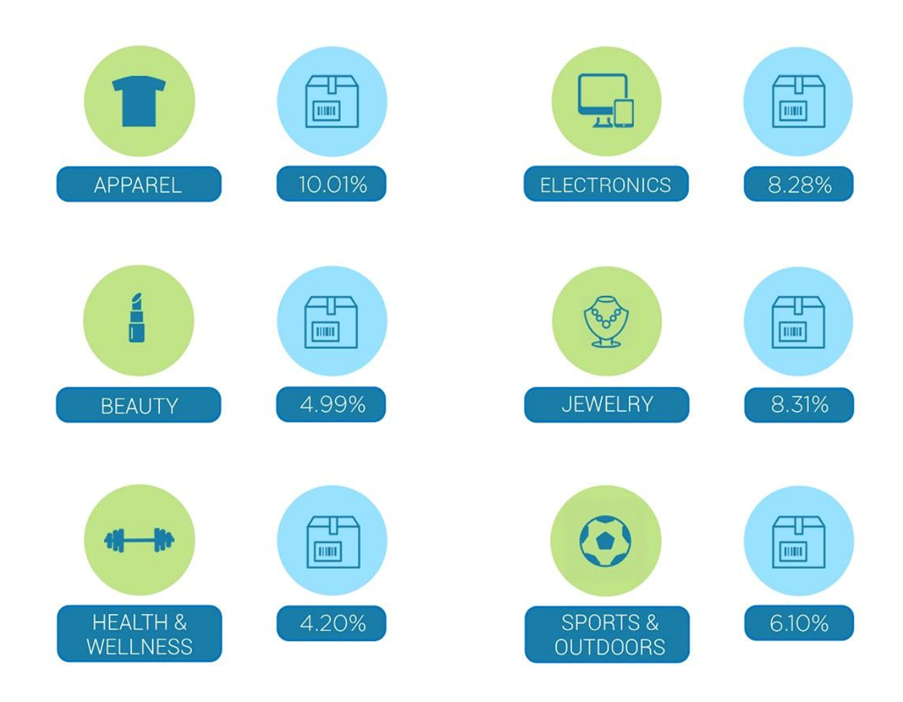As an online retailer you may be struggling with high return rates, which is not only time-consuming but can eat into your hard-earned profits, but you aren’t alone. Recent statistics reported by Richpanel show that on overage, return rates are around 20%-30% but may even be as high as 50% for high end items.
It also depends on which sector your business works within.
A 2020 study by e-commerce software company Shippo, found the following average rates by sector.

Image: Shippo
But what are the reasons for this?
- Product doesn't match the description: This is one of the most common reasons for returns, as customers may receive a product that looks different from what they saw online or has different features than what was described. According to a survey by Narvar, 61% of shoppers have returned an item because it didn't meet their expectations.
- Sizing issues: Clothes, shoes, and other apparel items can be difficult to purchase online since customers cannot try them on before purchasing. As a result, sizing issues are a common reason for returns. Body Labs, now owned by Amazon, found that 70% of shoppers said they would buy clothes online more often if they could be assured of the right fit.
- Damaged or defective products: Products that arrive damaged or defective can also lead to returns. Customers expect to receive products that are in good condition and functioning properly, and may return items that are not up to par. A survey by Shorr Packaging revealed that 31% of returns are due to damaged products.
- Late or delayed delivery: When customers order a product online, they expect it to arrive in a timely manner. If the product is delayed or takes longer to arrive than expected, customers may become frustrated and choose to return the item. MetaPack’s survey into returns found 96% of consumers said that delivery is an important factor in their overall online shopping experience.
- Changed mind or ordered the wrong item: Sometimes customers may simply change their mind or accidentally order the wrong item. This can lead to returns, even if the product is in good condition and meets the customer's expectations. According to a survey by Invesp, 23% of returns are due to customers changing their mind.
- Fraud: While it’s not something we like to think about, but, according to Small Business Trends, 9 in 10 ecommerce businesses have reported thieves returning items for stolen cash. They do this by making purchases with stolen credit cards and then take your money through returns.
While these are some of the main reasons why why customers may make returns, for the most part it doesn’t really matter why, you have to simply accept that returns will happen and while you won’t be able to prevent them, you can do things to reduce the number of orders that are returned.
The rule here is to put in place systems that manage returns efficiently, and prevent fraud, so you can protect your income while also offering those honest (and loyal) customers a customer experience they can trust.
So, how do you achieve that? Here are some top tips:
- Provide Accurate Product Descriptions
As we’ve highlighted, one of the main reasons customers return items is because the product they received didn't match the description on your website. To avoid this, make sure your product descriptions are accurate and detailed.
Include information such as size, colour, material, and any other relevant details. These will be backed up by additional information described below.
- Use High-Quality Product Images
In addition to accurate product descriptions, high-quality images are also important. Mobile users often have smaller screens, so it's essential to provide clear, well-lit images that show the product from different angles. This will help customers get a better sense of what the product looks like and reduce the likelihood of them returning it.
- Offer Detailed Sizing Information
Sizing can be a major issue for online retailers, especially when it comes to clothing and shoes. To reduce returns due to sizing issues, provide detailed sizing information for each product.
Include a detailed sizing chart, which shows waist circumference, inseam length, and shoe size conversions for overseas customers. Average customer feedback on sizing and even details of what size the model wears will also help.
- Provide Customer Reviews
Customer reviews can be a valuable resource for reducing returns. Encourage customers to leave reviews for your products and display them prominently on your website. This will give potential customers an idea of how the product fits, feels, and looks on real people. It will also help you identify any recurring issues or complaints, so you can address them and reduce the likelihood of returns.
- Offer Free Shipping and Returns
Believe it or not, offering free shipping and returns can be a powerful tool for reducing the cost of returns. Customers are more likely to make a purchase if they know they can easily return it for free if necessary.
By providing a seamless returns processing experience customers will still continue to shop with you and leave satisfied and glowing reviews. This can help build trust and loyalty with your customers, which can lead to repeat business in the future.
As those customers then shop more, they’ll return orders less.
- Make your return policies obvious
It’s simply good business to have a clear and detailed return policy on your website.
8 in 10 consumers read a returns policy before purchasing, and 72% of consumers say a simple return experience makes them more likely to shop from a business again in the future, so the importance of an effective return policy cannot be overstated.
Make sure your clear and concise returns policy is easily found in your website footer and also linked from product pages and a customer’s basket too.
With these ideas helping you to reduce return rates, how can you then reduce the cost of returns, and also protect yourself from fraud?
How can you reduce the cost of returns.
One great way of doing this is to offer an alternative product. Rather than returning the cash, highlight an alternative product to your customer that they may feel is novel and equivalent in value in exchange for the original product.
This could be an alternative size, colour or style or, by asking a few questions, something completely different that might be of more use.
They’ll be grateful for the time you’ve taken to help them and it will give you a chance to keep the value of the customer’s order and encourage them to become a return customer, rather than simply returning the item and leaving.
Another way is to offer ‘store credit’ directly if you’d prefer the customer to make their own choice. This way, you have the item returned but the customer’s cash value remains in your bank account until the customer is ready to purchase an alternative.
Giving them some time to use their credit means they can come back when they wish and order once they’ve had time to think.
To protect yourself from fraudulent returns, you can look at putting the following processes in place.
- Firstly, keep an eye out for serial returners. If you notice a customer frequently sending back products for no good reason, consider blocking their email or payment cards from your systems. But be careful not to ban loyal customers who have a high lifetime value.
- Secondly, it's worth considering purchasing fraud protection. This can help shield you from chargebacks or utilize a built-in system on your ecommerce platform like Shopify Fraud Protect or WooCommerce’s Anti-Fraud plugin.
- Thirdly, attaching tracking numbers to every product you ship out and having customers sign packages when they arrive can help you avoid disputes around undelivered items.
- Finally, only make payments for returns to the payment source, this way you can be sure the fraudster trying to swap a return for ‘cash’ into their own account is not able to.
Reducing return rates for your online store is certainly possible with the right strategies in place and also with the support of your mail logistics provider, who will be geared up to manage returns both in your own territory and overseas too.
Companies like Asendia, for example, have well-rehearsed procedures and unrivalled experience in getting orders to millions of customers worldwide, and handling with any returns they have too.
To find out more about how Asendia's leading international returns solution could help your business, get in touch.






